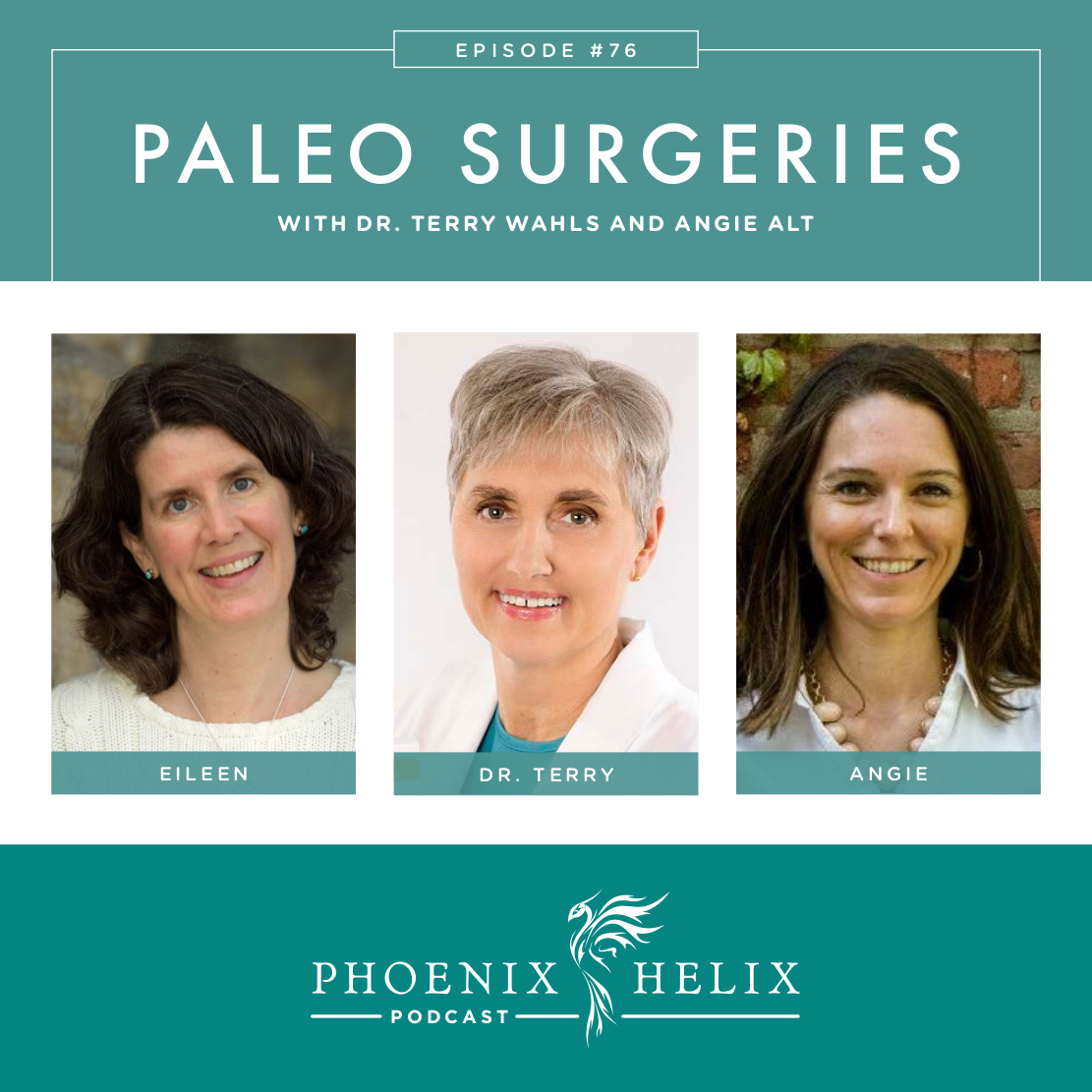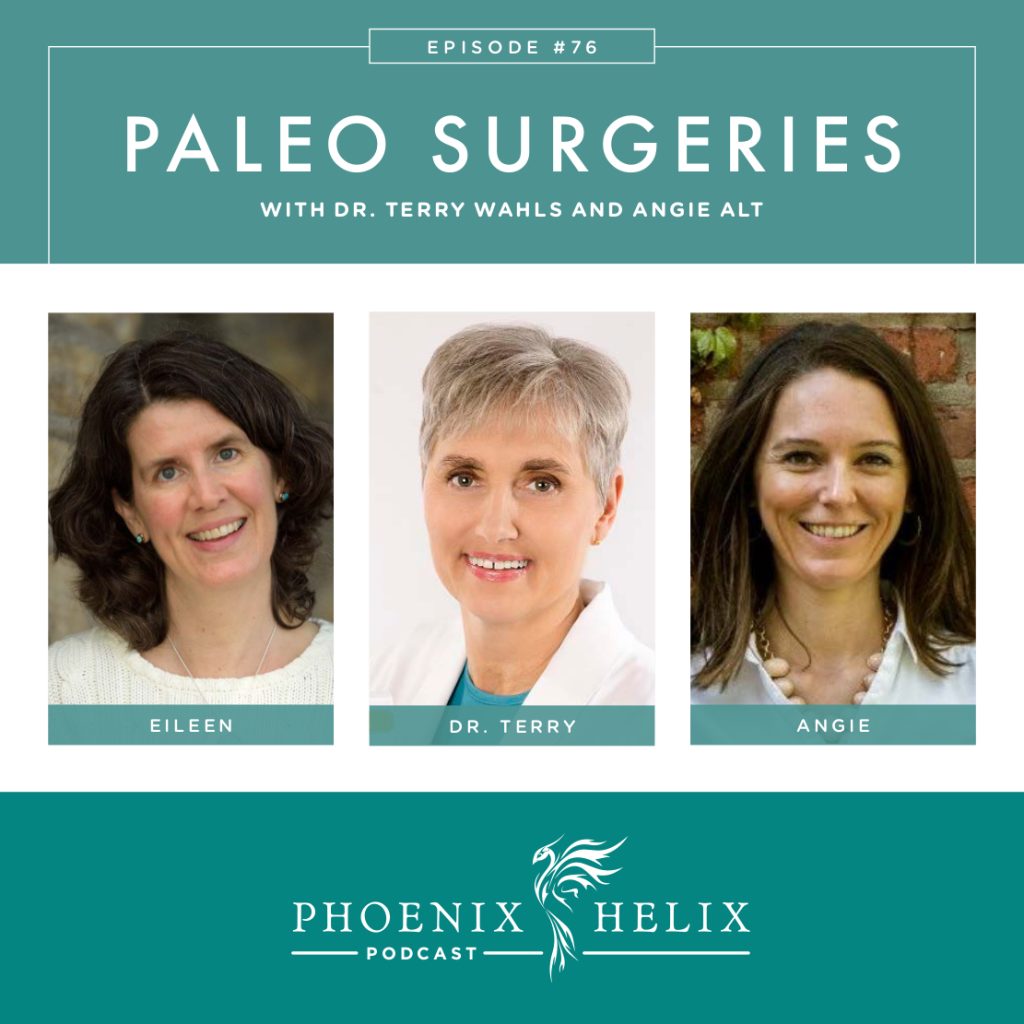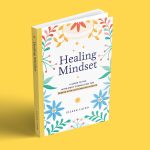How to Prepare for Surgery, Stay Paleo in the Hospital, and Support Your Recovery
Surgery can be a traumatic experience for the body – even more so for the autoimmune body – yet sometimes it’s necessary. So, how do we support our health: before, during, and afterward? There are no guarantees in life, but there are things we can do to stack the success odds in our favor. There are also ways to tap resilience when things don’t go according to plan. Dr. Terry Wahls, Angie Alt, and myself, have all had surgery while maintaining our healing diet and lifestyle. In this podcast we share our experience and tips.
Note: This website has a disclaimer on its legal page that is always in effect, but since we’re talking about medication and surgery in this episode, it seems prudent to add this reminder: all podcasts are educational in nature and not a substitute for medical advice. Always consult with your own medical team when making medical decisions.
Listen to the Show
- Subscribe to my podcast through your favorite podcast app: iTunes, Stitcher, Google, TuneIn, Spotify, Amazon, etc.
- You can also listen to the episode right here through the player below, and if you subscribe to my newsletter you’ll get notified of future episodes.
Podcast: Play in new window | Download
Show Notes
- Intro (0:00)
- Eileen’s Updates (2:13)
- Thank you to everyone who left a positive review on iTunes after last week’s episode! I did an “on air” step-by-step tutorial at time stamp 1:02:52 on Episode 75.
- On the weeks between podcasts, I write articles on my blog. This past week, I explored the question: If You Still Need Medication, What’s the Point of Paleo? If you don’t want to miss out, subscribe to my weekly newsletter.
- Thank You to Our Podcast Sponsor – Paleo on the Go (3:18)
- A frozen meal delivery service, they have a large menu of items for the paleo autoimmune protocol (AIP).
- Use the code PHOENIX for 10% off your first order.
- Meet Our Guests (4:05)
- Dr. Terry Wahls is the author of The Wahls Protocol and its companion cookbook, The Wahls Protocol Cooking for Life. 3 years after being diagnosed with multiple sclerosis, she had become disabled, spending most of her day in a tilt-recline wheelchair. This was in spite of taking the best medication available. She began researching other solutions – nutrition, ancestral health, functional medicine – and eventually developed The Wahls Protocol. She improved dramatically until she eliminated her need for the wheelchair and began biking again. She now teaches her protocol worldwide and also conducts clinical trials into its application for autoimmune health. If you’d like to hear more of Dr. Terry’s story, listen to Episode 7, watch her TED Talk, or visit her website.
- Angie Alt is the author of The Alternative Autoimmune Cookbook and co-author of The Autoimmune Wellness Handbook. She has celiac disease, lichen sclerosus, and endometriosis. She went undiagnosed for celiac disease for over a decade and experienced worsening symptoms bodywide, including joint pain, nerve issues, and mental health problems. After starting the paleo autoimmune protocol, the vast majority of her symptoms went away. If you’d like to hear more of Angie’s story, listen to Episode 1 or visit her website.
- The Decision to Have Surgery (7:45)
- Dr. Terry had back surgery to address spinal stenosis and scoliosis. Over the past few years, she had developed back pain and muscle weakness which interfered with her ability to stand, walk, and sleep. MRI’s showed no MS involvement, and her neurologist referred her to a back surgeon. She tried everything else first, hoping to avoid surgery – including acupuncture, physical therapy, and regular use of an inversion table. At her worst, she couldn’t stand more than 4 minutes at a time and realized she was becoming disabled again, which motivated her to have the surgery. While her doctors say that her back condition has nothing to do with MS, Dr. Terry does see a connection. Her years in the wheelchair and resulting muscle atrophy affected the shape of her spine, which she believes contributed to the development of stenosis.
- Angie has had 3 laparascopic surgeries for endometriosis and 2 of those were after she transitioned to the paleo autoimmune protocol. While her overall health greatly improved on the AIP – including her endometriosis symptoms – her disease didn’t go away altogether. She has severe stage 4 endometriosis and in 2016 it perforated the wall of her sigmoid colon. Surgery was necessary.
- Eileen had shoulder replacement surgery to address damage caused by rheumatoid arthritis. The paleo autoimmune protocol reduced her symptoms by 95% but didn’t put her into complete remission. In 2016, she experienced a spike in autoimmune activity that quickly reduced range-of-motion in her left shoulder. She chose to go on medication to try to halt the disease process and recently achieved remission. However, the damage to the shoulder was irreversible. After trying physical therapy, acupuncture and many forms of bodywork and energywork with minimal improvement, Eileen agreed to a surgical consult. The x-rays and MRI showed that all cartilage was gone, and severe erosions had changed the shape of the bones. Surgery was necessary.
- Paleo Perfectionism: Sometimes when the paleo diet and lifestyle doesn’t cure us of our health problems, we doubt its effectiveness altogether. But perfection isn’t the only definition of success. A nutrient-dense, anti-inflammatory diet helps minimize autoimmune symptoms, often improves other health conditions, and helps us reclaim vitality, strength and joy in our lives. The same is true for the benefits of healthy lifestyle choices. While it’s natural to grieve what isn’t “fixed”, be sure to celebrate all the benefits you do receive. Paleo and conventional medicine don’t have to be either/or choices. We can be grateful that both are available to help us live our healthiest lives.
- Finding a Good Surgeon (18:29)
- Dr. Terry’s advice: Get multiple opinions. If you know anyone in the medical field, they often have inside information on the most respected surgeons in your area. Don’t be afraid to shop around.
- Angie’s advice: If your surgery is complex, research surgeons outside of your area as well. For her most recent surgery, she went to the top endometriosis surgeon in the country. She got his name in an endometriosis patient education group.
- Eileen’s advice: Ask everyone you know, because even if they haven’t had surgery themselves, they may know someone who has. The more recommendations you get for the same doctor, the more confidence you can have in their abilities. If you’re looking for the best surgeons in the country, you can do a google search for your specific surgery: “Best _______ surgeon USA”. (International listeners, insert your country’s name in place of USA.)
- Preparing for Surgery (23:05)
- Dr. Terry worked with her functional medicine physician on a supplement protocol that supported her detox pathways and microbiome, since surgery challenges both of these. She also made a clear plan with her family regarding the food she would need while she was in the hospital and the assistance she would need at home afterward. Her wife took 2 weeks off from work to provide that care. After surgery, you will need some help at home even if everything goes well (and more so if you run into complications). Social workers at the hospital will want to know your plans. If you are single, reach out to friends, family and/or access the healthcare services available in your area. Postpone any elective surgery until these plans are in place.
- Angie: 30 days prior to surgery, she went back on the AIP elimination phase and also focused on nutrient-density. She took supplements that would promote wound healing (Vitamin C), reduce inflammation, and support detoxification. Like Dr. Terry, she also focused on probiotics and fermented foods to support her microbiome. It’s important to tell your medical team about your supplements, because some may be contraindicated before surgery. For example, some interfere with blood clotting ability which would be dangerous. She also tried to prioritize rest in those 30 days as well. It’s tempting to work hard to get everything done pre-surgery, but you don’t want to go to surgery with your body in a stressed and depleted state. She also focused on mindset: positive visualization, meditation, and prayer. She hired a health coach to help her through this preparation process.
- Eileen increased her nutrient-density before surgery: bone broth, organ meat, high-quality seafood, and plenty of vegetables. She also focused heavily on the mind-body piece, because she didn’t want to enter the hospital feeling any fear or grief. Instead, she wanted to feel gratitude. Techniques that helped her were: journaling, The Work by Byron Katie, and EFT. And on the day of surgery itself, in addition to deep breathing, she practiced Loving Kindness Meditation for every staff member involved in the surgery.
- Eating Paleo in the Hospital (32:55)
- Dr. Terry was in the hospital just one night. She made sure her medical chart listed “life threatening allergies to gluten, dairy, and eggs”. Even so, a nurse tried to tell her she could only eat hospital food and wouldn’t be allowed to eat food from home. Dr. Terry insisted otherwise until she was granted permission. Don’t be afraid to advocate for yourself as a patient. The food her family brought included bone broth, a smoothie, and fermented foods: both sauerkraut and kombucha.
- Angie was in the hospital for 5 days, and then had to stay at a nearby hotel for a week before her follow-up appointment with her surgeon. (She traveled for her surgery). Her business partner and friend, Mickey Trescott, flew across the country to provide the food, along with another friend who lived locally: Sarah Ballantyne. They cooked Angie lots of bone broth, liver paté, gelatin gummies, and puréed soups. Angie followed her doctor’s advice, beginning with a liquid diet and slowly progressing to solid foods as allowed, but all of her food was paleo AIP. Angie’s hospital had no objection to her food plan.
- Eileen was in the hospital 36 hours. Bone broth was her last food before surgery and first food afterward. She packed a cooler in the morning with her dinner, knowing that her arm would be in a sling, so she choose finger food that was easy to eat, along with a smoothie. (She’s left-handed, and her surgery was on the left side). Her husband brought her a similar breakfast the next day, and she also brought some Wild Zora AIP-friendly protein bars, in case she got hungry overnight. She encountered no resistance from hospital staff about eating her own food, and she simply declined all food offers from the hospital kitchen.
- Antibiotics (38:41)
- They are prescribed to prevent potentially life-threatening surgical site infections and are a mandatory part of every surgery. If you refuse antibiotics, your surgeon will refuse to do the surgery. Dr. Terry developed severe diarrhea related to the antibiotics, which took 2 weeks to resolve and resulted in a 20 pound weight loss and delayed recovery. She believes her history of taking potato starch as a prebiotic supplement made her vulnerable to a C. difficile infection. She warns everyone against that supplement now. She cured the infection through high doses of VSL#3 probiotics (now sold under the name Visbiome), and Saccharomyces boulardii in consultation with her functional medicine physician. She’s also intrigued by fecal microbiota transplants to treat C. difficile, but that wasn’t an option unless she took further rounds of antibiotics first, which she was unwilling to do.
- Eileen and Angie tolerated the antibiotics without complications.
- Pain Management (44:21)
- Narcotics are the most common pain medication prescribed following surgery. Pain relief is important to the ability to sleep and heal, yet these come with side effects and can also become addictive quickly. Dr. Terry chose to avoid them altogether. Angie was able to take them with minimal side effects and had no trouble stopping them when they were no longer needed. Eileen experienced both side effects and addiction/withdrawal symptoms when going off them.
- Common narcotics side effects: constipation, nausea, dizziness, headaches and sedation. Non-codeine narcotics (dilauid) are sometimes better tolerated than codeine-based narcotics (oxycontin, percocet). Angie took a stool softener to help with constipation. Resource article: 7 Ways to Reduce Nausea on the AIP.
- Common narcotics withdrawal symptoms: insomnia, restless legs, anxiety, irritability, fatigue, muscle aches, hot & cold sweats, nausea, vomiting, diarrhea. For Eileen, the worst of the symptoms passed after 4 days, but sleep disturbances continued for 2 months. While her experience was definitely uncomfortable, it was mild on the spectrum of addiction, and she was able to withdraw at home. For people with severe narcotics addiction, treatment is recommended. Some things that helped Eileen were removing all narcotics from the house, skullcap tea, crocodile breathing, and mind-body techniques.
- Dr. Terry chose to avoid the narcotics and took essential oils internally instead, under the guidance of her functional medicine physician (marjoram, lemongrass, and frankincense) Caution: internal use of essential oils can be toxic and doses need to be monitored carefully. Don’t attempt this without the advice of an expert, and be sure they a food-grade essential oils. While the essential oils managed Dr. Terry’s pain, her pain tolerance is quite high. She also uses meditation for pain relief. Resource: Guided Meditation for Coping with Pain.
- Angie: because she tolerates narcotics well, they are a pain treatment she appreciates post-surgery.
- Eileen: due to her narcotics sensitivity, she would seek other solutions in the future. For this surgery, NSAIDs (which she tolerates well) were contraindicated because they can interfere with bone healing. She was prescribed a 3-day nerve block but due to lack of supplies at the hospital, only received 1-day. A 3-day block might have been enough to meet her pain management needs.
- Resource article: Chris Kresser’s Healing Regimen for Injuries and Surgeries.
- If you choose an alternative pain relief protocol, be sure to tell your doctor what you’re taking. Even natural supplements can have unintended effects and can interfere with surgical healing. Communication is important. Resource podcast: Building Effective Doctor-Patient Relationships.
- Stopping Medications Before and After Surgery (55:45)
- Your surgeon will give you a timeline for starting and stopping any medication or supplement that can cause surgical complications. Be sure to give them a complete list of everything you are taking.
- Dr. Terry had to eliminate most of her supplements two weeks prior to surgery, to reduce risk of excess bleeding. Unfortunately, this left her in a high level of pain pre-surgery which also interfered with sleep. Comfort measures she employed during this time included meditation and her inversion table. She’s also developed an ability to bear pain over her years with MS. She was able to start her supplements again 48 hours post-surgery.
- Eileen had to stop her immunosuppressant medication 1 week prior to surgery and was allowed to resume 2 weeks afterward. Since she hadn’t taken prednisone in over 6 months, that wasn’t a risk factor for her. Otherwise, she would have needed to receive prednisone during and after surgery to support her adrenals. She had to stop her supplements 3 days prior to surgery and was able to start again when she was discharged from the hospital. Eileen was in remission prior to surgery and had no negative response to this break in her medication/supplement protocol.
- Sleep and Comfort Measures in the Hospital (58:55)
- It is very challenging to sleep in a hospital due to discomfort, sounds, activity and interruptions. But there are things you can bring with you to try to help.
- Eileen downloaded a white noise app on her iPhone, and that helped mask many of the noises.
- Angie brought her favorite pillow and blanket, and the narcotics helped her sleep initially. But after 5 days of poor quality sleep, she developed a severe migraine. Thankfully, the doctor discharged her that day, because he saw that the cause was lack of sleep.
- We also brought along distractions to help pass the time. Eileen brought her kindle, and Angie brought a laptop where she could stream some of her favorite TV shows.
- When it comes to visitors in the hospital, don’t be afraid to ask for what you need – whether that be time alone or the supportive presence of someone you love. (And it’s hard to predict in advance which you’ll prefer.)
- Supporting Recovery at Home (1:05:07)
- Surgery is an event, and recovery is a process. Be gentle and patient with yourself through that process. Recovery takes time.
- In addition to nutrient density, focus on rest, and positive mind-body techniques to ease the stress of surgery recovery and any frustration/impatience you might feel through the process.
- Make a food plan. Due to her antibiotic complications, Dr. Terry needed a puréed diet – lots of soups and bone broth. Then, as her infection cleared and diarrhea improved, she was able to slowly progress to solid foods again. Angie stayed in an extended-stay hotel following discharge from the hospital, in order to attend her follow-up appointment with her surgeon a week later, before traveling home. Mickey and Sarah provided the food for them during that week. Eileen ordered enough meals from Paleo on the Go to feed both her and her husband for the first week following surgery. She remembered how exhausting it was to be the caregiver when he had surgery, so she wanted to ease his burden for that first week.
- Lymph drainage therapy can support and speed up the healing process, and often is a service offered in physical therapy offices. Ask your surgeon for a referral.
- Traumeel is a homeopathic cream that Eileen used to reduce swelling and help heal the bruising.
- Surgical Outcomes (1:12:21)
- Dr. Terry: Her surgical complications delayed her recovery, but 18 months later, she is able to walk a mile and stand for 30 minutes without pain. While she had hoped for more, the surgery greatly reduced her pain and improved her function, and she sees it as a success. She’s glad she had the surgery.
- Angie had a minor complication following surgery, but the surgery was successful in removing endometriosis tissue that was not only causing pain but also putting her in danger. While it wasn’t a cure, she feels it was very helpful and the right decision for her.
- Eileen is also grateful she had the surgery. Rheumatoid arthritis complicates her recovery due to some excess scar tissue surrounding the joint. But she has dramatically improved her range of motion and her shoulder pain is 100% gone. She’s continuing physical therapy exercises, which slowly stretch that scar tissue and increase her range of motion every month.
- Financial Stress and the Cost of Surgery (1:17:15)
- Surgery is very expensive, and depending on insurance coverage, your out-of-pocket costs can run from low to very high. Because her surgeon was “out of network”, Angie experienced the stress of unexpected medical bills, in spite of doing advance research. Here’s her advice:
- Part of your surgery plan should also be a financial plan. Do your research and try to discover in advance what is covered and what isn’t. Then, build up your savings to cover your portion of the expense, with an extra buffer if possible.
- If you cannot afford certain bills, try negotiating with providers – both the physicians and the hospital (which usually send separate bills). Resource article: Cutting Medical Bills.
- Some employers also have programs to help their employees with uncovered healthcare expenses. Ask your human resources department whether or not your company offers that benefit.
- Surgery is very expensive, and depending on insurance coverage, your out-of-pocket costs can run from low to very high. Because her surgeon was “out of network”, Angie experienced the stress of unexpected medical bills, in spite of doing advance research. Here’s her advice:
- Resources (1:22:32)
- Angie’s written two great articles on her blog: Surgery – The AIP Way, Part 1 and Part 2.
- Outro (1:22:48)
- Dr. Terry Wahls is the author of The Wahls Protocol and The Wahls Protocol Cooking for Life. You can follow her work through her website. She is also currently recruiting applicants for a research study comparing the Swank Diet to the Wahls Diet in the treatment of MS. And she is fundraising for a study into the Wahls Protocol for ALS. To follow and support this research, check out the Wahls Foundation.
- Angie Alt is the author of The Alternative Autoimmune Cookbook and co-author of The Autoimmune Wellness Handbook. You can follow her work through her website: Autoimmune Wellness, and she also co-hosts the Autoimmune Wellness Podcast.
- Eileen (your podcast host) is the author of multiple books, written to help people thrive with autoimmune disease. Learn more on the Books Page.
- If you like this podcast, follow or subscribe through your favorite podcast app. You can also subscribe to Eileen’s biweekly newsletter.
- Check out the entire archive of podcast episodes.
You May Also Be Interested In
Spreading the Word
If you like the podcast, please leave a positive review in iTunes. It would mean the world to me, and also helps others find the podcast. Here are some quick instructions using your iPhone:
- If you are already subscribed to my podcast: (1) Click the purple podcast icon. (2) At the bottom of the screen, click Library. (3) At the top of the screen, click Shows. (4) Click the Phoenix Helix podcast image. (5) Scroll down the page, and you’ll see Ratings and Reviews. Scroll down a little bit more and click on Write a Review. This will bring up the review screen. Tap 5 stars (if you love the podcast), and then click in the title box, and it will bring up the keyboard. Enter a title and short review. (6) Click Send in the upper right corner. (7) Thank you! Positive reviews give the podcast a higher search ranking in iTunes, helping people find it and letting them know it’s a quality podcast and worth their time to listen.
- If you haven’t subscribed to my podcast: (1) Click the purple podcast icon. (2) In the lower right corner, click the magnifying class. (3) Type Phoenix Helix in the search box. (4) Click the podcast cover in the Show list. (5) If you’d like to subscribe, click the + sign at the top of the screen. (6) To write a review, scroll down the page, and you’ll see Ratings and Reviews. Scroll down a little bit more and click on Write a Review. This will bring up the review screen. Tap 5 stars (if you love the podcast), and then click in the title box, and it will bring up the keyboard. Enter a title and short review. (7) Click Send in the upper right corner. (8) Thank you! Positive reviews give the podcast a higher search ranking in iTunes, helping people find it and letting them know it’s a quality podcast and worth their time to listen.









